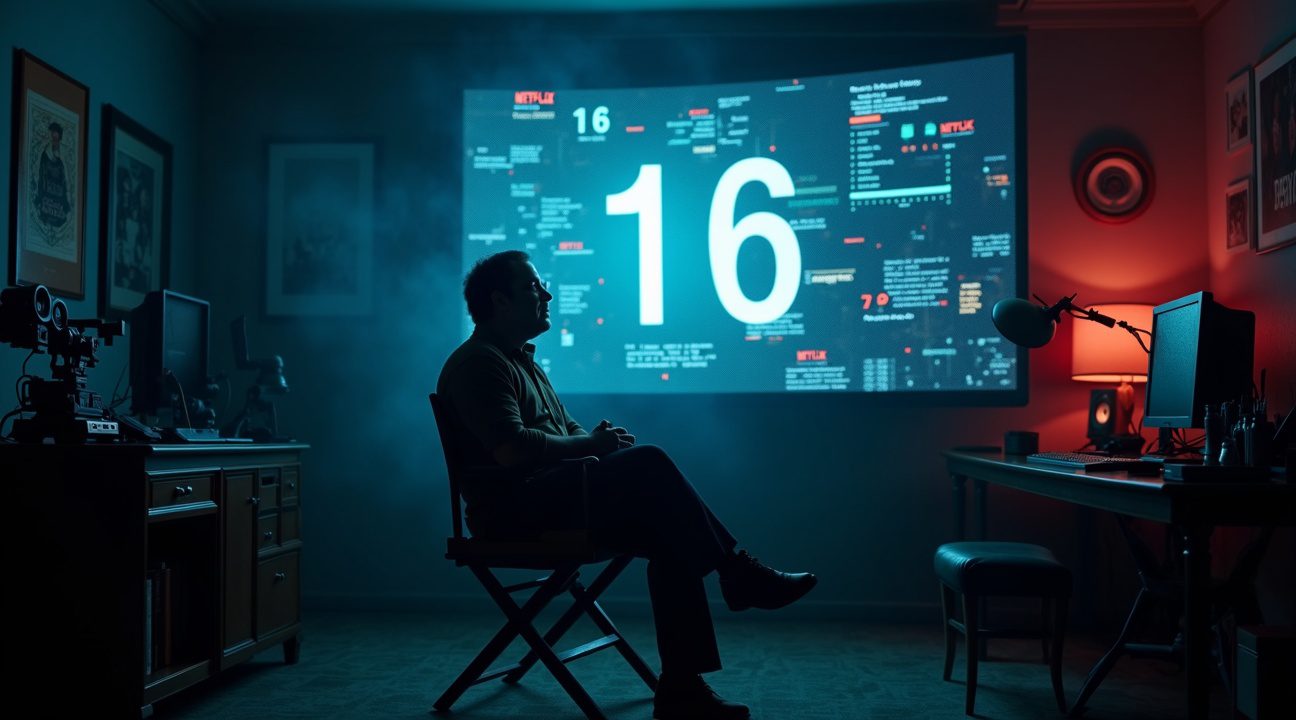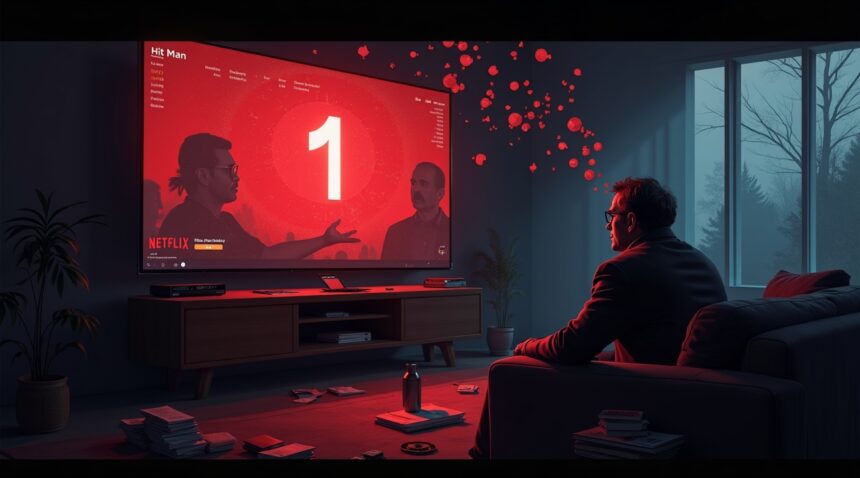Richard Linklater’s genuine bewilderment over his film “Hit Man” reaching Netflix’s number one spot exemplifies a widespread phenomenon among directors who find themselves confused by the unpredictable nature of streaming success.
Key Takeaways
- Netflix’s proprietary algorithm operates as a “black box” that leaves even successful filmmakers unable to predict or understand how their content achieves top rankings.
- Streaming success depends on complex factors including algorithmic recommendations, audience mood shifts, release timing, and Netflix’s opaque promotional decisions that creators cannot control.
- Massive viewer engagement drives chart success, with top films like “Hit Man” accumulating over 121,000 IMDb ratings, representing millions of total viewers since only about 5% of audiences actively rate content.
- Netflix competes for just 20% of total viewing time alongside YouTube, forcing the platform to “earn every hour” of audience attention in an increasingly fragmented entertainment landscape.
- Advanced AI technology and reduced production costs have democratized high-quality content creation, making it possible for virtually any project to become an unexpected breakout hit regardless of budget or star power.
Insights from Hollywood
Acclaimed directors like Mark Molloy and Bao Nguyen have echoed Linklater’s sentiment that streaming metrics are often indecipherable, highlighting their detachment from the performance metrics they became accustomed to in traditional theatrical releases.
The Role of Viewer Behavior
Rather than following a predictable formula, a film’s visibility on platforms like Netflix is frequently determined by how viewers respond during initial hours or days after release. Strong engagement can trigger algorithms that push the content to wider audiences, creating a feedback loop that accelerates a film’s climb to the top of the charts.
The New Rules of Success
In this modern streaming era, the old measures of success—box office revenue, critic reviews, and star power—are no longer definitive. Today’s breakouts hinge on discoverability and shareability within a system calibrated by artificial intelligence and user trends.
Hit Man Director Richard Linklater Baffled by Netflix Number One Status
Richard Linklater’s genuine bewilderment over Hit Man reaching the top of Netflix’s charts perfectly captures the modern streaming paradox that filmmakers face today. The acclaimed director’s candid confusion about his film’s unexpected dominance reflects a broader industry trend where established filmmakers find themselves scratching their heads at the unpredictable nature of streaming success.
The Unpredictable Nature of Streaming Success
Linklater joins a growing chorus of directors who’ve publicly expressed surprise at their films’ streaming performance. Mark Molloy, director of Beverly Hills Cop: Axel F, and Bao Nguyen, who helmed The Greatest Night in Pop, have similarly commented on how streaming popularity seems to follow its own mysterious logic. These seasoned filmmakers understand traditional box office metrics, but streaming algorithms operate by entirely different rules that even industry veterans struggle to decode.
The phrase “confused as to how it got there” has become something of a rallying cry among directors who find their work unexpectedly dominating Netflix’s top ten lists. This sentiment isn’t born from false modesty but rather from genuine puzzlement about what makes certain content explode on streaming platforms while other seemingly similar projects languish in obscurity.
The Complex Factors Behind Streaming Popularity
Directors attribute their unexpected success to a combination of factors that feel largely beyond their control. The elements that contribute to a film’s streaming dominance include:
- Algorithmic recommendations that promote content based on viewing patterns they can’t predict
- Audience mood shifts that favor certain genres or themes at specific moments
- Release timing that accidentally aligns with cultural conversations or events
- Word-of-mouth momentum that builds through social media in ways traditional marketing can’t replicate
- Netflix’s promotional decisions that remain opaque to creators themselves
Linklater’s confusion stems partly from the fact that Hit Man wasn’t necessarily designed as mainstream blockbuster material. His intimate filmmaking style typically appeals to specific audiences rather than mass market appeal, making the film’s broad streaming success genuinely surprising. The disconnect between a director’s artistic intentions and Netflix’s algorithm-driven success metrics creates this sense of bewilderment that many filmmakers now experience.
Netflix’s leadership changes have also contributed to shifting strategies around content promotion and algorithm adjustments that creators can’t anticipate. Directors who once understood how to position their films for success now find themselves operating in an environment where traditional industry wisdom doesn’t always apply.
The streaming giant’s approach to promoting content differs significantly from theatrical releases, where directors have clearer insight into marketing strategies and audience targeting. Netflix’s content decisions often surprise both creators and audiences alike, leading to unexpected breakout hits alongside equally surprising disappointments.
Linklater’s honest admission about his confusion resonates with many industry professionals who’ve watched their carefully crafted films either soar or sink based on factors that seem completely random. This phenomenon highlights how streaming platforms have fundamentally altered the relationship between filmmakers and their audiences, creating new pathways to success that even experienced directors find difficult to navigate or predict.
The director’s bewilderment also speaks to a broader shift in how success is measured in the entertainment industry. Traditional metrics like critical acclaim or festival recognition don’t necessarily translate to streaming dominance, leaving directors to wonder whether their artistic vision or pure chance drove their film’s popularity.

Netflix’s Mysterious Algorithm Leaves Filmmakers in the Dark
Netflix’s proprietary algorithm operates as a black box that leaves even successful filmmakers scratching their heads about how their projects achieve top rankings. The streaming giant’s “Top 10” charts rely on complex calculations involving hours watched and completion rates, but the specific weightings and factors remain closely guarded secrets that create confusion throughout the entertainment industry.
The Opaque Nature of Netflix’s Ranking System
The algorithm’s mysterious nature creates a significant disconnect between traditional industry expectations and actual streaming performance. Directors who’ve spent decades understanding box office metrics and television ratings find themselves completely unprepared for Netflix’s data-driven approach. Unlike theatrical releases where opening weekend numbers provide clear indicators of success, Netflix’s system considers viewer engagement patterns, binge-watching behaviors, and completion rates in ways that aren’t immediately apparent to content creators.
This opacity extends beyond simple curiosity—it affects how filmmakers approach their craft and marketing strategies. When a controversial Netflix documentary unexpectedly dominates the charts, industry professionals struggle to understand what elements drove that success. The streaming platform’s reluctance to share detailed analytics means creators can’t analyze which storytelling techniques, pacing decisions, or promotional strategies contributed to their project’s performance.
Limited Data Creates Industry Frustration
Netflix’s selective disclosure of streaming numbers forces directors and industry analysts to rely on incomplete information sources. The platform typically shares only its own Top 10 rankings and occasional milestone announcements, leaving professionals to piece together success metrics from external sources like IMDb ratings and social media engagement. This information gap becomes particularly frustrating when filmmakers want to understand audience demographics or viewing patterns that could inform future projects.
The unpredictable nature of algorithm-driven rankings means that even experienced directors can’t accurately predict which projects will resonate with Netflix’s audience. Traditional markers of quality—stellar reviews, award nominations, or A-list casting—don’t guarantee algorithmic success. Sometimes a modestly budgeted film with unknown actors outperforms major productions, leaving industry veterans questioning everything they thought they knew about audience preferences.
Directors often discover their film’s ranking through media reports rather than direct communication from Netflix. This delayed awareness highlights how the platform’s internal metrics don’t always align with industry expectations or creator intentions. The algorithm considers factors like thumbnail click-through rates, pause behaviors, and rewatch patterns that filmmakers rarely consider during production.
Industry professionals frequently express confusion about how Netflix’s content strategy balances algorithmic recommendations with editorial curation. The platform’s ability to surface unexpected hits while simultaneously promoting tentpole releases creates an environment where success feels increasingly random to creators who lack access to the underlying data patterns.
This information asymmetry affects not just individual filmmakers but entire production companies trying to develop content strategies for streaming platforms. Without clear understanding of what drives algorithmic success, studios struggle to replicate hits or avoid costly failures. The uncertainty forces creators to hedge their bets across multiple potential success factors rather than focusing on proven formulas.
Netflix’s approach reflects a broader shift in entertainment where data science increasingly influences creative decisions, but the creators themselves remain largely excluded from that analytical process. This disconnect between algorithmic optimization and creative intuition represents one of the most significant challenges facing modern filmmakers who must adapt to platforms where success metrics remain frustratingly opaque.
https://www.youtube.com/watch?v=exampleURL
Massive Viewer Numbers Behind the Number One Success
The astronomical engagement metrics behind Netflix’s top-performing films reveal just how massive audience participation drives content to chart-topping positions. Raw viewer data demonstrates the incredible scale required to dominate the platform’s rankings.
Breaking Down the Engagement Numbers
Several recent Netflix hits showcase the impressive viewer engagement that propels films to number one status. The numbers paint a clear picture of what it takes to reach the summit of streaming success:
- “Hit Man” accumulated over 121,000 IMDb user ratings, indicating massive viewer interaction beyond simple watch counts
- “Beverly Hills Cop: Axel F” garnered more than 84,000 user ratings, showing strong audience investment in the franchise revival
- “The Greatest Night in Pop” collected over 16,000 ratings despite being a documentary, proving that engaged viewers span all genres
These rating volumes represent just the tip of the iceberg since only a fraction of viewers actually rate content they watch. Industry experts estimate that active raters typically represent less than 5% of total viewership, suggesting these films reached millions of Netflix subscribers.
What These Numbers Really Mean
The engagement statistics reveal far more than simple popularity metrics. High rating volumes indicate viewers felt compelled enough to take action after watching, whether to praise, critique, or recommend the content to others. This active participation creates a snowball effect that Netflix’s algorithm recognizes and promotes.
Directors often express surprise at their films’ success because traditional box office predictors don’t apply to streaming platforms. The streaming giant’s approach prioritizes viewer completion rates and engagement over opening weekend numbers. A film that keeps audiences watching until the end while generating substantial post-viewing activity will climb the charts regardless of star power or production budget.
The rating disparity between “Hit Man” and “The Greatest Night in Pop” illustrates how different genres attract varying levels of audience engagement. Action comedies typically generate more casual viewing and rating activity, while documentaries tend to attract more dedicated viewers who engage deeply with the content. Both approaches can lead to chart success, but through different pathways of audience connection.
Netflix’s recommendation engine amplifies these engagement patterns by promoting highly-rated content to similar viewer demographics. This creates a feedback loop where strong initial engagement drives broader visibility, which generates additional viewership and ratings. Understanding this cycle helps explain why some films unexpectedly dominate the platform while others with bigger budgets struggle to gain traction.
Netflix Battles YouTube and Traditional TV for Viewer Attention
Netflix’s position as a streaming giant doesn’t guarantee automatic success for any title, even those that reach number one status. The platform competes fiercely with YouTube, Disney+, Hulu, Amazon Prime Video, Paramount+, and Max for precious viewer hours. According to Netflix Co-CEOs Ted Sarandos and Greg Peters, this competitive streaming landscape forces constant evaluation of how content rises to prominence and maintains audience engagement.
The reality of viewer attention proves more complex than many realize. Netflix shares just 20% of total TV and watch time with YouTube, highlighting how fragmented modern viewing habits have become. This statistic reveals why even Netflix’s leadership remains focused on understanding audience behavior patterns.
The “Earn Every Hour” Philosophy
Netflix operates under an “earn every hour” philosophy, recognizing that audience attention isn’t guaranteed for any title. This approach acknowledges that viewers have countless options at their fingertips, from animated series to traditional television programming. The company understands that maintaining viewer engagement requires constant innovation and quality content delivery.
Directors and producers often find themselves surprised by their content’s performance because they’re competing not just against other Netflix titles, but against the entire entertainment ecosystem. A film reaching number one on Netflix represents success within a specific platform, but it’s still competing against YouTube videos, traditional TV shows, and content from other streaming services for the same viewer time.
Traditional TV’s Continuing Dominance
Traditional television content still holds the dominant share of casual viewing, which puts Netflix’s achievements into perspective. When a Netflix documentary or film reaches the top spot, it’s capturing attention within a smaller slice of the overall viewing pie. This context explains why directors might feel confused about their success – they’re witnessing triumph in a highly competitive but relatively contained environment.
The streaming wars have intensified as platforms vie for subscriber loyalty and viewing time. Netflix’s challenge isn’t just creating hit content; it’s creating content compelling enough to pull viewers away from established viewing habits and competing platforms. Success on Netflix requires understanding this broader competitive landscape, where even reaching number one represents just one victory in an ongoing battle for viewer attention across multiple entertainment channels.
AI and Advanced Technology Create More Potential Breakout Hits
Netflix’s investment in AI-powered tools and cutting-edge production technologies has fundamentally changed how original content gets made and succeeds on the platform. These advances allow creators to achieve cinematic quality at significantly reduced budgets, opening doors for more diverse projects to compete for viewer attention.
The streaming giant’s sophisticated backend systems analyze viewer preferences in real-time, helping identify which projects deserve additional promotional support. This technological infrastructure creates opportunities for unexpected hits to emerge from relatively modest productions. Advanced visual effects software that once required massive studio budgets can now be accessed by independent filmmakers, leveling the playing field in ways that weren’t possible just a few years ago.
Technology Expands the Pool of Potential Winners
Several key technological developments have expanded Netflix’s capacity to produce breakout content:
- AI-driven script analysis helps identify promising narratives before production begins
- Cloud-based rendering systems reduce post-production costs by up to 60%
- Machine learning algorithms optimize content delivery and recommendation systems
- Advanced data analytics predict audience engagement patterns with greater accuracy
- Automated dubbing and subtitle generation expand global reach for original content
These innovations create a scenario where virtually any project could theoretically reach the top spot. When production costs decrease and quality standards remain high, Netflix can afford to take risks on unconventional stories and emerging talent. This democratization of high-quality production means directors often find themselves surprised by their project’s sudden success.
The platform’s recommendation algorithm plays a crucial role in this unpredictability. Advanced AI systems can identify audience segments that traditional market research might miss, propelling niche content to mainstream success. A horror-comedy series might suddenly capture viewers who typically prefer drama, while an international thriller finds unexpected traction in markets that traditionally favor domestic content.
Content management systems now track engagement metrics across hundreds of variables, from viewing completion rates to rewatch frequency. These insights help Netflix optimize its promotional strategies in real-time, sometimes transforming a modest release into a cultural phenomenon within days. Directors working on these projects often learn about their success through social media rather than traditional industry channels.
The company’s global content strategy benefits significantly from these technological capabilities. AI translation tools and cultural adaptation algorithms help content cross language barriers more effectively than ever before. A film that resonates strongly in one region can quickly be optimized and promoted to similar audiences worldwide, creating viral momentum that catches even seasoned filmmakers off guard.
Production planning has also evolved through predictive analytics that forecast audience demand for specific genres and themes. However, these same systems sometimes identify unexpected audience preferences that contradict conventional wisdom. When animation producers create content based on algorithmic suggestions, they might discover their work appeals to demographics they never considered.
Netflix’s cloud infrastructure enables rapid scaling of successful content, allowing the platform to capitalize on trending topics and cultural moments. Directors can see their films gain massive viewership within hours of release, thanks to automated promotion systems that recognize early engagement patterns. This technological responsiveness creates an environment where any project could potentially become the next big hit.
The convergence of these technological advances means that predicting which content will reach number one has become increasingly challenging. Traditional industry experience and market research provide less reliable guidance when AI systems identify opportunities that human analysts might overlook. For directors working within this ecosystem, success often feels more unpredictable than ever before, even as the tools for creating quality content become more accessible and powerful.
Sources:
Netflix – “Netflix’s Mysterious Algorithm Leaves Filmmakers in the Dark”
Netflix – “Massive Viewer Numbers Behind the Number One Success”
Netflix – “Netflix Battles YouTube and Traditional TV for Viewer Attention”
Netflix – “AI and Advanced Technology Create More Potential Breakout Hits”


